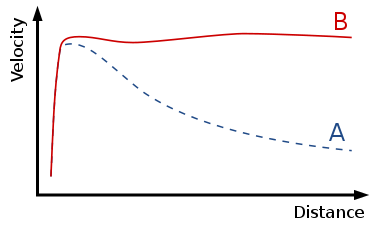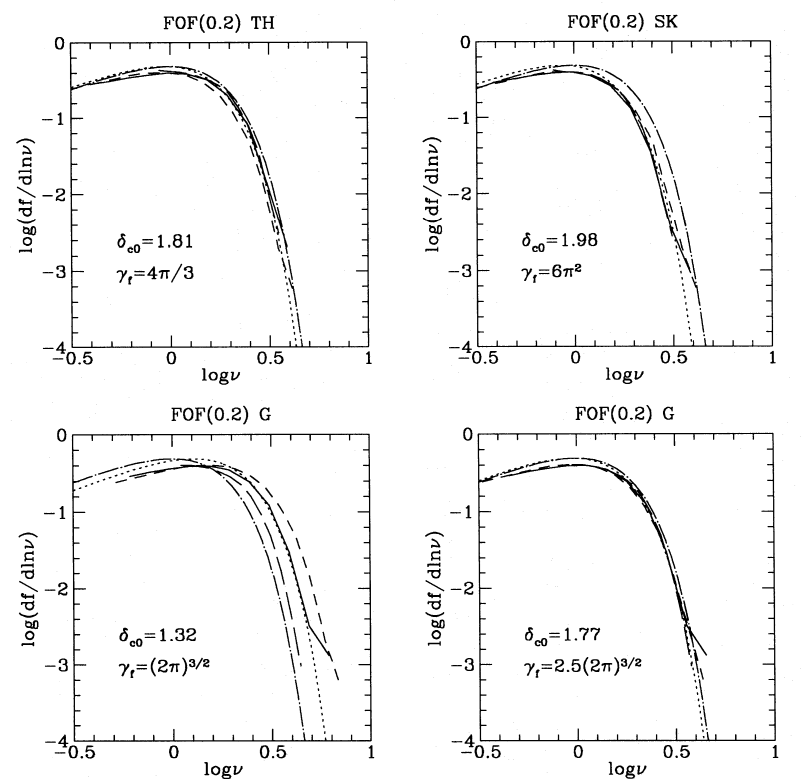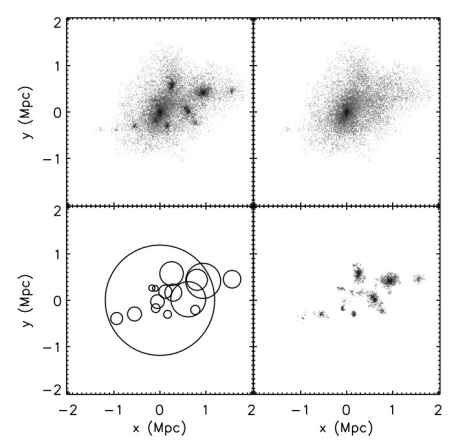1. Introduction
Humans initially found galaxy as a time-wasting figure for identifying comets two hundred years ago. Since then, the majority of cosmology has focused on galaxy research. The basic picture of galaxy formation was first proposed by White and Rees. They pointed out that galaxies form in two stages: dark matter halos first form during collisionless gravitational collapse, and then baryon gas falls into the centers of these dark halos due to energy consumption by radiation. Obviously, this process involves many other physical processes in addition to gravitational effects. We know very little about most of its processes, and we know even less about the most important physical processes, such as star formation and supernova feedback, which can only be described by empirical formulas. Therefore, at present and for a long time to come, the study of star The study of galaxy formation is undoubtedly a very challenging and important topic. But we now understand that galaxies are the fundamental components of the cosmos. Astronomers have derived systematic principles for identifying distinct types of galaxies as a result of the huge number of observations gathered over the past several decades. Galaxies are classified according to their diameters (RGal), masses (MGal), densities (fGal), distances, and speeds (ZGal). To comprehend the fundamental formation process, it is necessary to develop an accurate model of galaxies. In recent years, precise data and a wide range of appropriate models have been generated with assurance due to the development of technology. However, major limits of detecting methods may still exist, which may compromise or even jeopardize the accuracy of the employed model and its reproduction, hence misleading the prediction ability. This post will mostly address three aspects. (1) observation aims; (2) physical and cosmological formation processes and simulation models; and (3) observation methods.
2. Observation targets
In this section of the essay, we will examine the most fundamental reasons for conducting further inquiry. Primarily, we will analyze astronomical objects, stars, gas, and dark matter, which will aid us in evaluating and comprehending the necessary facts. Second, and more importantly, we shall investigate the distribution and correlation of major galaxies.
2.1. Stars and gas
Optical observations indicate that the bulk of galaxies consist of two distinct components: a spherical core of dense stars and a thin disc of stars and gas. Both portions of the galaxy are unique and relatively isolated. Multiple theories addressing the kinematic process preceding the regularly seen occurrence have been developed by scientists in attempt to comprehend the physical foundations of this deposition [1-2]. The early hypothesis of galaxy formation relies largely on gas dissipation and star formation to explain the Hubble sequence [3]. In later studies, however, more methods [4] and models such as TREESPH [5] are developed. As a result, we understand that the formation of galaxies requires more than stars and gas; rather, dark matter is present in considerably bigger amounts. However, according to scientific traditions, the implications of star formation are still being assessed. When the gas is cooled and its self-gravitational force finally exceeds the gravity of dark matter, it will collapse into the center of the halo and pursue the development of a Giant Molecular Cloud (GMC). During such a collapse, the gas will form a dense core that will provide the energy for nuclear fusion [6, 7]. The exact mechanism of star creation remains poorly known. Specifically, we are unable to examine many details of time scale and lack knowledge on the mass percentage of stellar growth, as mass distribution is a major determinant of a star's characteristics. Initial Mass Function (IMF) is crucial for defining the luminosity, mass, distribution, and ultimate fate of a star [8].
Salpeter’s Initial Mass Function:
\( ξ(m)∆m={ξ_{0}}{(\frac{m}{{M_{Θ}}})^{-2.35}}(\frac{Δm}{{M_{Θ}}})\ \ \ (1) \)
2.2. Dark Matter
As can be seen in figure 1, it is now general known that baryonic matter accounts for only 10 percent of the galaxy's total mass. In 1844, scientists discovered the presence of dark matter for the first time [9]. In actuality, the absence of dark matter would have a substantial impact on galaxy behavior. Throughout the 1960s and 1970s, several dark matter-related investigations are conducted. According to assessments of galaxy curves, the galaxy appears to be rotating at an extremely rapid rate [10]. Therefore, several observations were conducted in the 1970s and 1980s [11] with a focus on dark matter, revealing that a non-visible halo constituted 90% of the entire mass of the galaxy. Identification of halos is essential for the development of models including N-body simulation and, eventually, merger trees. There are already a variety of indirect ways for detecting dark matter halos and sub halos; nonetheless, the composition of a major portion of dark matter remains unknown. The theory of general relativity might give a basic explanation of gravitational lensing, but reliable detection may be challenging due to the fact that dark matter can exist in a number of forms and, as a result, has a broad range of physical properties [12].

Figure 1. Credit from Wikipedia, the curve A represent the velocity predicted through virial theorem and the curve B represent the velocity observed.
2.3. Galaxies correlations
In 1926, Edwin Hubble created the Hubble sequence to categorize galaxies according to their shapes and appearances [13]. This categorization is essential for the study of galaxy evolution. The Hubble sequence categorizes galaxies into four primary groups: elliptical, spiral, lenticular, and irregular. Why do galaxies seem differently? Does the form of galaxies depend on their initial mass and kinematics, or has something else consistently altered their initial shape? Numerous observations on the evolution route of younger galaxies and frequent astronomical events, like as galactic mergers, have been done to solve this topic. According to early studies of galaxies, the initial collapse would eventually create a spherical structure surrounded by a gaseous and star-filled disc. Then, it will be understood that elliptical galaxies are created by intense galactic collisions simulated using models and merger simulations [14]. There are ways for building equilibrium models in the study of spiral galaxies, allowing researchers to evaluate the evolution process of multi-core galaxies [15].
3. Overview of physical process by models and feedbacks
\( R=\frac{\sum _{acc.sat.}{M_{cold gas}}+{M_{stars}}}{{({M_{cold gas}}+{M_{stars}})_{central galaxy}}}\ \ \ (2) \)
Credit from Bulge et al. 1996 This equation determined whether a merger is ‘violent’.
In the subsequent part, we will utilize theories and data to study the origin of galaxies. We will investigate the physical and cosmological mechanism that drives the development of galaxies using a number of modified models.
3.1. Gravity
In regions of the cosmos where there is an abundance of dark matter, gravity is the driving force behind galaxy formation. The spectrum of early universe primordial fluctuations reflects the amount of dark matter halo that collapses into galaxies and pursues mergers, as well as the displacement of dark matter clusters. Using simulations like as N-body simulation [16] and other modified f (R) gravity models [17], we are now able to explore further into galaxy clusters and superclusters. In addition, the spectrum of early universe primordial fluctuations reflects the quantity of dark matter halo that collapses (IllustrisTNG).

Figure 2. The rewritten mass function that calculate the fraction of mass in halo [18].
\( \frac{df}{dln v}={(\frac{2}{π})^{\frac{1}{2}}}vexp(-\frac{{v^{2}}}{2}) \ \ \ (3) \)
Credit from Lacey 1994 (figure 2), shows average mass function for the different N-body models may substantially affect a galaxy's structure, the amount of supermassive black holes (SMBH), Mergers and the pace at which stars originate. This section concentrates mostly on certain modified gravity models, particularly the hybrid N-body simulation [18]. In this procedure, a substantial amount of the universe is fragmented into particles, the system is allowed to evolve, and a relationship is formed between the spectrum of initial linear density fluctuations and the mass distribution as well as the merging of collapsed objects. Various techniques, including friends-on-friends (FOF) and spherical overdensity, are utilized to identify halos in a hybrid particle-particle-mesh (P3M) model (SO). In spite of the numerous varied applications and comparisons done utilizing the various N-body models, the outputs are often trustworthy.
3.2. Hydrodynamic

Figure 3. illustrating a computing field of a continuous gravitational field (credit from Price 2010).
As shown in figure 3, simulations of hydrodynamics have played a key role in the research of galaxy formation. In the past several decades, tremendous strides have been made to model the birth of a single galaxy by adjusting outflows to examine the inflows and composition of galaxies. Ionized gas and energetic feedbacks from major astronomical objects (such as SMBHs and massive stars) significantly dictated the galaxy's outflow, allowing us to examine the galaxy's composition. Smooth Particle Hydrodynamics [19-20] is one of the most well-known models; in summary, SPH evaluates the density by expressing, for instance, a collection of point masses in a continuous gravity field, mass distribution, or kernel-weighted sum across adjacent particles. Another approach is referred to as Semi-analytic modeling (SAM), which does not solve the basic equation for particles or cells but instead binds their instantaneous position and other factors, such as velocity, into a simplified bulk flow and stresses the significant history of halo merging [21].
In addition, hydrodynamic models are utilized to examine ab initio events occurring within the framework of dark matter's structure. The significance of the conservation of angular momentum of cooling gas in the creation of the galactic disk cannot be overstated. The cooling gas is projected to have the same angular momentum as the dark matter halo created by the first tidal force [22-24]. This will make the creation of the galactic disk possible. To have any chance of comprehending the ab initio process, we must concentrate on the conservation of energy during mergers, the contraction of baryonic matter during the gas-cooling phase, and the formation of stars [22]. The Schechter luminosity function [23], for instance, is utilized extensively because it is so excellent in describing space density based on brightness (figure 4).

Figure 4. Illustrating halo and sub halo by AdaptaHOP [21].
4. Conclusion
This work is primarily concerned with galaxy formation and associated models. We detail the physical and cosmological processes that occur during galaxy formation and describe the theories developed by astrophysicists. As a consequence of breakthroughs in computer and numerical simulations, galaxy formation models have developed over the last several decades. It provides us with some insight into the formation of galaxies, although being relatively inconclusive.
References
[1]. Thorsten Naab, Jeremiah P. Ostriker. “Theoretical Challenges in Galaxy Formation.”, ARXIV, 3–4 (2016)
[2]. Rachel S. Somerville. “Physical Models of Galaxy Formation in a Cosmological Framework.”, 8 December 2014. Accessed 27 July 2022. ARXIV, 3–6 (2014)
[3]. Richard B. Larson. “Models for the Formation of Disc Galaxies.” Monthly Notices of the Royal Astronomical Society, 176(1), 31–52 (1976)
[4]. John H., Stephen R., “The Complexity of N-body Simulation,” Automata, Languages and Programming. 162–176 (1993)
[5]. Neal Katz, David H. Weinberg, Lars Hernquist, “Cosmological Simulations with TreeSPH,” ARXIV, 3-5 (1995)
[6]. Houjun Mo, Frank van den Bosch, Simon White, “Galaxy Formation And Evolution,” Cambridge, ISBN-13 978-0-511-72962-1, 8-9 (2010)
[7]. Houjun Mo, Frank van den Bosch, Simon White, “Galaxy Formation And Evolution,” Cambridge, ISBN-13 978-0-511-72962-1, 544, 9 (2010)
[8]. Salpeter, Edwin E, “The Luminosity Function and Stellar Evolution.,” Astrophysical Journal, 121, 161 (1955)
[9]. Trimble Virginia, “EXISTENCE AND NATURE OF DARK MATTER IN THE UNIVERSE,” ANNUAL REVIEW OF ASTRONOMY AND ASTROPHYSICS, 25, 425 (1987)
[10]. Vera Rubin, “Rotation of the Andromeda Nebula from a Spectroscopic Survey of Emission Regions,” Astrophysical Journal, 159, 379 (1970)
[11]. Albert Bosma, “THE DISTRIBUTION AND KINEMATICS OF NEUTRAL HYDROGEN IN SPIRAL GALAXIES OF VARIOUS MORPHOLOGICAL TYPES,” PhD Thesis, chapter3 (1978)
[12]. Anderson, Paul R.; Brill, Dieter R., “Gravitational geons revisited,” physical Review D, 56, 4824-4833 (1997)
[13]. Hubble Edwin, “No. 324. Extra-galactic nebulae.,” Contributions from the Mount Wilson Observatory / Carnegie Institution of Washington, 324, 1-49 (1926)
[14]. C. M. Baugh, S. Cole and C. S. Frenk, “Evolution of the Hubble sequence in hierarchical models for galaxy formation,” Monthly Notices of the Royal Astronomical Society, 283, 1361-1378 (1996)
[15]. Hernquist L. Ap. J. 86, 389–400 (1993)
[16]. Trenti Michele, Hut Piet, “N-body simulations (gravitational),” Scholarpedia, 3, 3930 (2008)
[17]. Fabio Fontanot, Ewald Puchwein, Volker Springel, Davide Bianchi, “Semi-analytic galaxy formation in f(R)-gravity cosmologies,” Monthly Notices of the Royal Astronomical Society, 436, 2672–2679 (2013)
[18]. Cedric Lacey, Shanu Cole, “Merger rates in hierarchical models of galaxy formation – II. Comparison with N-body simulations,” Monthly Notices of the Royal Astronomical Society, 271, 676-692 (1994)
[19]. Monaghan J. J., “Smoothed particle hydrodynamics,” In: Annual review of astronomy and astrophysics, 30, 543-574 (1992)
[20]. Daniel Price, “Smoothed Particle Hydrodynamics and Magnetohydrodynamics,” ARXIV, (2010)
[21]. D. Tweed, J. Devriendt, J. Blaizot, S. Colombi and A. Slyz, “Building merger trees from cosmological N-body simulations,” A&A, 506, 647–660 (2009)
[22]. Binney J. Ap. J. 21, :483–491 (1977)
[23]. Schechter, P. "An analytic expression for the luminosity function for galaxies". The Astrophysical Journal. 203, 297–306 (1976)
[24]. C. M. Baugh, A. J. Benson, S. Cole, C. S. Frenk, C. G. Lacey, “Ab initio galaxy formation,” arXiv:astro-ph/9907056, 1-6 (1999)
Cite this article
Xu,Z. (2023). Galaxy formation and evolution. Theoretical and Natural Science,11,60-65.
Data availability
The datasets used and/or analyzed during the current study will be available from the authors upon reasonable request.
Disclaimer/Publisher's Note
The statements, opinions and data contained in all publications are solely those of the individual author(s) and contributor(s) and not of EWA Publishing and/or the editor(s). EWA Publishing and/or the editor(s) disclaim responsibility for any injury to people or property resulting from any ideas, methods, instructions or products referred to in the content.
About volume
Volume title: Proceedings of the 2023 International Conference on Mathematical Physics and Computational Simulation
© 2024 by the author(s). Licensee EWA Publishing, Oxford, UK. This article is an open access article distributed under the terms and
conditions of the Creative Commons Attribution (CC BY) license. Authors who
publish this series agree to the following terms:
1. Authors retain copyright and grant the series right of first publication with the work simultaneously licensed under a Creative Commons
Attribution License that allows others to share the work with an acknowledgment of the work's authorship and initial publication in this
series.
2. Authors are able to enter into separate, additional contractual arrangements for the non-exclusive distribution of the series's published
version of the work (e.g., post it to an institutional repository or publish it in a book), with an acknowledgment of its initial
publication in this series.
3. Authors are permitted and encouraged to post their work online (e.g., in institutional repositories or on their website) prior to and
during the submission process, as it can lead to productive exchanges, as well as earlier and greater citation of published work (See
Open access policy for details).
References
[1]. Thorsten Naab, Jeremiah P. Ostriker. “Theoretical Challenges in Galaxy Formation.”, ARXIV, 3–4 (2016)
[2]. Rachel S. Somerville. “Physical Models of Galaxy Formation in a Cosmological Framework.”, 8 December 2014. Accessed 27 July 2022. ARXIV, 3–6 (2014)
[3]. Richard B. Larson. “Models for the Formation of Disc Galaxies.” Monthly Notices of the Royal Astronomical Society, 176(1), 31–52 (1976)
[4]. John H., Stephen R., “The Complexity of N-body Simulation,” Automata, Languages and Programming. 162–176 (1993)
[5]. Neal Katz, David H. Weinberg, Lars Hernquist, “Cosmological Simulations with TreeSPH,” ARXIV, 3-5 (1995)
[6]. Houjun Mo, Frank van den Bosch, Simon White, “Galaxy Formation And Evolution,” Cambridge, ISBN-13 978-0-511-72962-1, 8-9 (2010)
[7]. Houjun Mo, Frank van den Bosch, Simon White, “Galaxy Formation And Evolution,” Cambridge, ISBN-13 978-0-511-72962-1, 544, 9 (2010)
[8]. Salpeter, Edwin E, “The Luminosity Function and Stellar Evolution.,” Astrophysical Journal, 121, 161 (1955)
[9]. Trimble Virginia, “EXISTENCE AND NATURE OF DARK MATTER IN THE UNIVERSE,” ANNUAL REVIEW OF ASTRONOMY AND ASTROPHYSICS, 25, 425 (1987)
[10]. Vera Rubin, “Rotation of the Andromeda Nebula from a Spectroscopic Survey of Emission Regions,” Astrophysical Journal, 159, 379 (1970)
[11]. Albert Bosma, “THE DISTRIBUTION AND KINEMATICS OF NEUTRAL HYDROGEN IN SPIRAL GALAXIES OF VARIOUS MORPHOLOGICAL TYPES,” PhD Thesis, chapter3 (1978)
[12]. Anderson, Paul R.; Brill, Dieter R., “Gravitational geons revisited,” physical Review D, 56, 4824-4833 (1997)
[13]. Hubble Edwin, “No. 324. Extra-galactic nebulae.,” Contributions from the Mount Wilson Observatory / Carnegie Institution of Washington, 324, 1-49 (1926)
[14]. C. M. Baugh, S. Cole and C. S. Frenk, “Evolution of the Hubble sequence in hierarchical models for galaxy formation,” Monthly Notices of the Royal Astronomical Society, 283, 1361-1378 (1996)
[15]. Hernquist L. Ap. J. 86, 389–400 (1993)
[16]. Trenti Michele, Hut Piet, “N-body simulations (gravitational),” Scholarpedia, 3, 3930 (2008)
[17]. Fabio Fontanot, Ewald Puchwein, Volker Springel, Davide Bianchi, “Semi-analytic galaxy formation in f(R)-gravity cosmologies,” Monthly Notices of the Royal Astronomical Society, 436, 2672–2679 (2013)
[18]. Cedric Lacey, Shanu Cole, “Merger rates in hierarchical models of galaxy formation – II. Comparison with N-body simulations,” Monthly Notices of the Royal Astronomical Society, 271, 676-692 (1994)
[19]. Monaghan J. J., “Smoothed particle hydrodynamics,” In: Annual review of astronomy and astrophysics, 30, 543-574 (1992)
[20]. Daniel Price, “Smoothed Particle Hydrodynamics and Magnetohydrodynamics,” ARXIV, (2010)
[21]. D. Tweed, J. Devriendt, J. Blaizot, S. Colombi and A. Slyz, “Building merger trees from cosmological N-body simulations,” A&A, 506, 647–660 (2009)
[22]. Binney J. Ap. J. 21, :483–491 (1977)
[23]. Schechter, P. "An analytic expression for the luminosity function for galaxies". The Astrophysical Journal. 203, 297–306 (1976)
[24]. C. M. Baugh, A. J. Benson, S. Cole, C. S. Frenk, C. G. Lacey, “Ab initio galaxy formation,” arXiv:astro-ph/9907056, 1-6 (1999)









